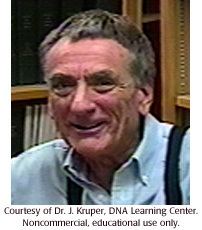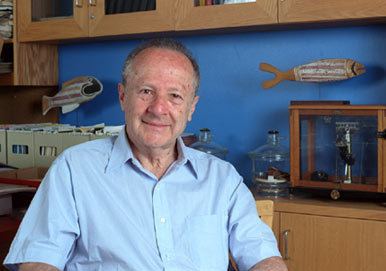Name Franklin Stahl | Citizenship USA Role Geneticist | |
 | ||
Born October 8, 1929 (age 96) Boston, Massachusetts ( 1929-10-08 ) Known for Meselson-Stahl experiment Books Genetic Recombination: Thinking about it in Phage and Fungi, The Mechanics of Inheritance Education University of Rochester (1956), Harvard University (1951), California Institute of Technology Awards MacArthur Fellowship, Guggenheim Fellowship for Natural Sciences, US & Canada Fields | ||
Meselson and Stahl Experiment | Lecture 5 | Semi conservative DNA Replication
Franklin (Frank) William Stahl (born October 8, 1929) is an American molecular biologist and geneticist. With Matthew Meselson, Stahl conducted the famous Meselson-Stahl experiment showing that DNA is replicated by a semiconservative mechanism, meaning that each strand of the DNA serves as a template for production of a new strand.
Contents
- Meselson and Stahl Experiment Lecture 5 Semi conservative DNA Replication
- Career
- Personal life
- Experimental contributions
- Theoretical contributions
- Selected honors
- References

He is Emeritus Professor of Biology at the University of Oregon's Institute of Molecular Biology in Eugene, Oregon.

Career

Stahl, like his two older sisters, graduated from the public schools of Needham, a Boston suburb. In 1951, he was awarded an AB degree in biology from Harvard College, and matriculated in the biology department of the University of Rochester. His interest in genetics was cemented in 1952 by his introduction to bacterial viruses (phages) in a course taught by A. H. (Gus) Doermann at the Cold Spring Harbor Biological Laboratory. In 1956, he received a PhD in biology for his work with Doermann on the genetics of T4 phage. In 1955, he undertook postdoctoral studies with Giuseppe Bertani (in the Phage group) at Caltech (Pasadena) with the aim of learning some bacterial genetics. He subsequently turned his attentions to collaborations with Charley Steinberg and Matt Meselson. With Steinberg, he undertook mathematical analyses of T4 growth, mutation, and genetic recombination. With Meselson, he studied DNA replication in Escherichia coli. That study produced strong support for the semiconservative model proposed by Jim Watson and Francis Crick.
For one year, Stahl served on the zoology faculty at the University of Missouri in Columbia, Missouri before accepting, in 1959, a position in the new Institute of Molecular Biology at the University of Oregon in Eugene. In the succeeding years, his research involved the phages T4 and Lambda and the budding yeast, Saccharomyces cerevisiae, with his primary focus on genetic recombination. He taught various genetics courses at Oregon and presented phage courses in America, Italy and India. He undertook sabbatical studies in Cambridge, UK, Edinburgh, Jerusalem, and Cambridge, Massachusetts.
Stahl's research was undertaken in association with numerous colleagues, especially his long-tem associates Jean M. Crasemann (1921–1992), Mary M. Stahl (1935–1996), and Henriette (Jette) M. Foss (1937–date). Since his retirement in 2001, he lives with Jette and four llamas in Eugene, where he continues to submit research papers and participates in University of Oregon governance.
Personal life
Stahl and his wife Mary (married in 1955) raised two boys and a girl. Surviving are Andy Stahl, a forester and political activist, and Emily Morgan, a hairdresser and shop owner. With his partner, Jette, he shares five children (plus spouses) and eight grandchildren, of whom five are adopted.
Experimental contributions
In bacteria:
In phage T4:
In Lambda:
In Yeast:
Theoretical contributions
Selected honors
1997- Fellow, American Academy of Microbiology
1996 Thomas Hunt Morgan Medal (from Genetics Society of America)
1986- Associate Member EMBO
1985- American Cancer Society Research Professor
1985-1990 MacArthur Fellow
1981- Member, American Academy of Arts and Sciences
1976- Member, National Academy of Science
1975-76; 1985-1986 Guggenheim Fellow
1969-70 NIH Special Postdoctoral Fellowship
Honorary Doctor of Science: Oakland University and University of Rochester
